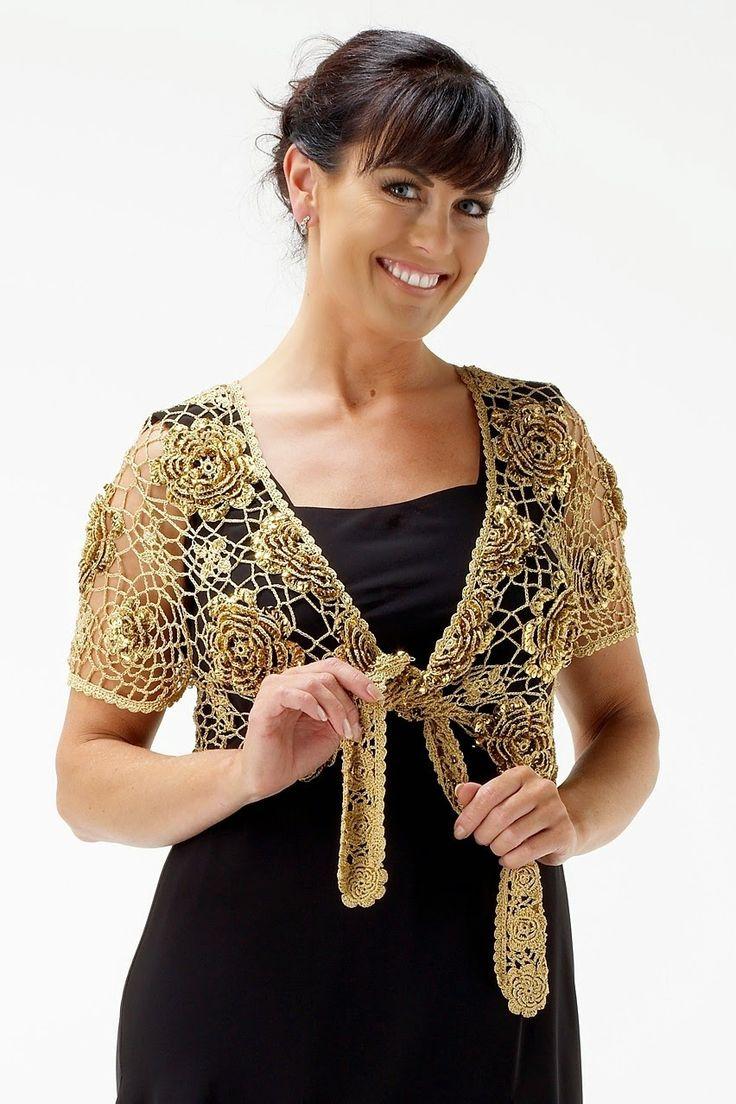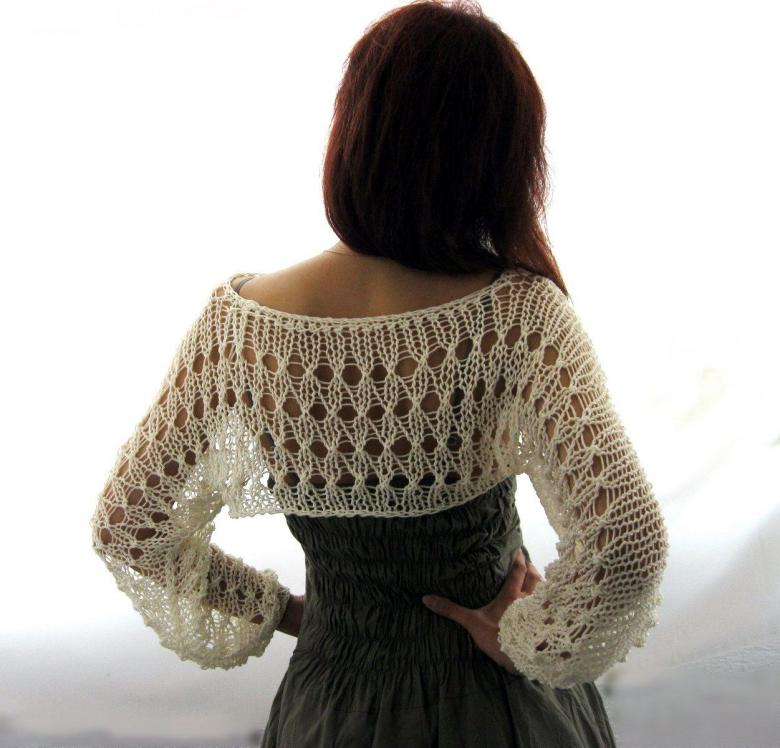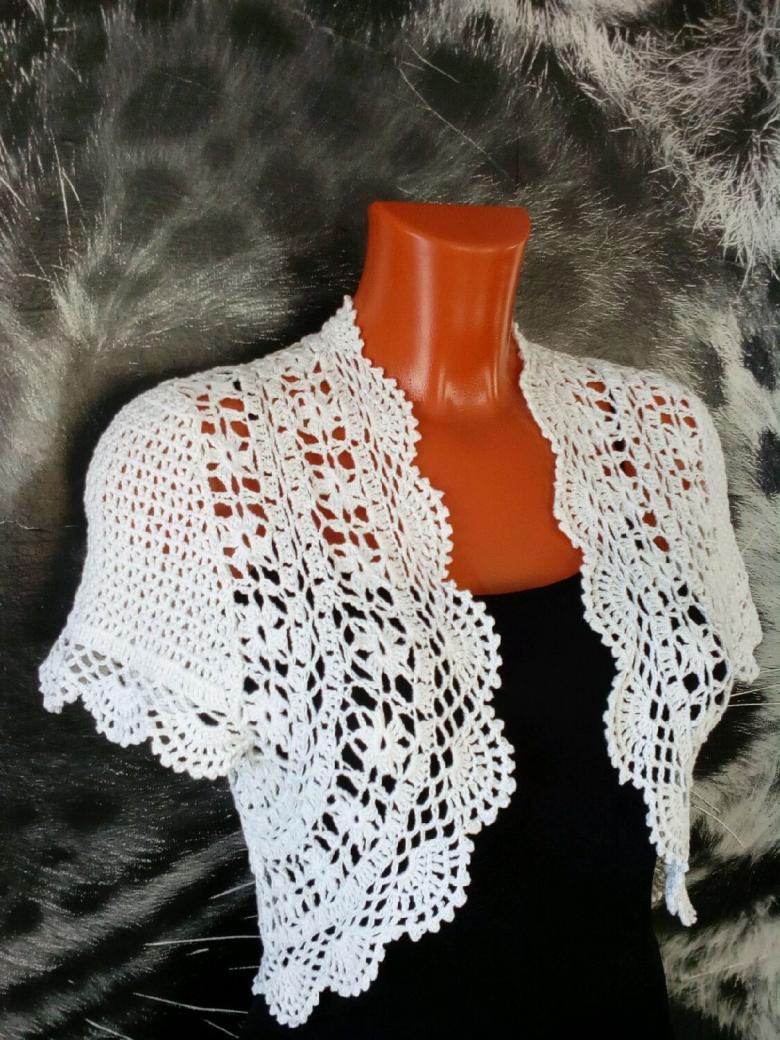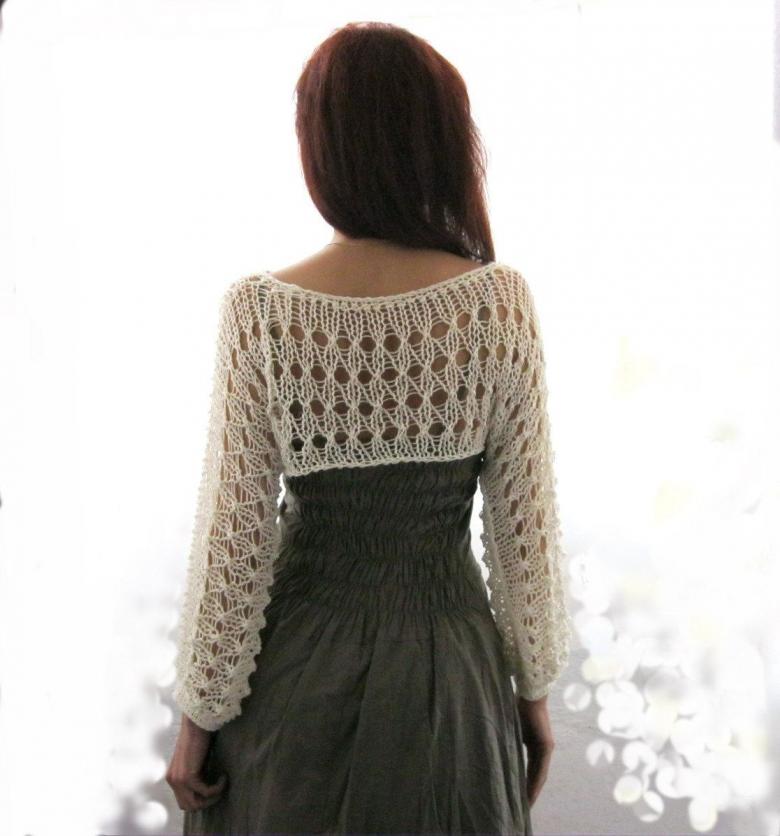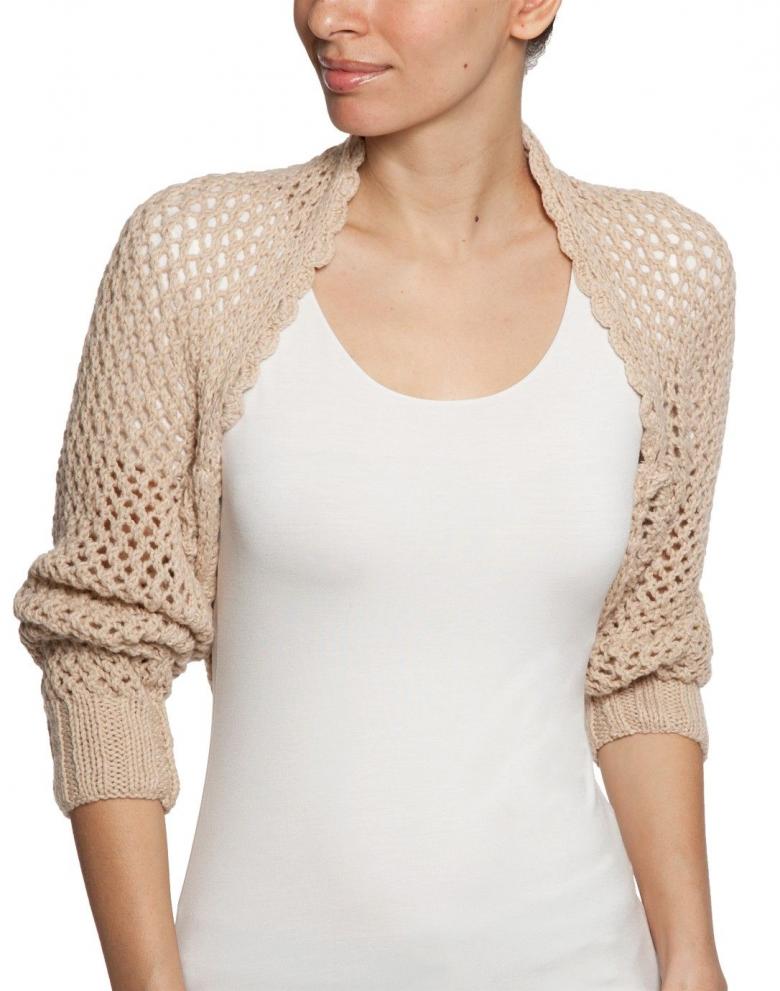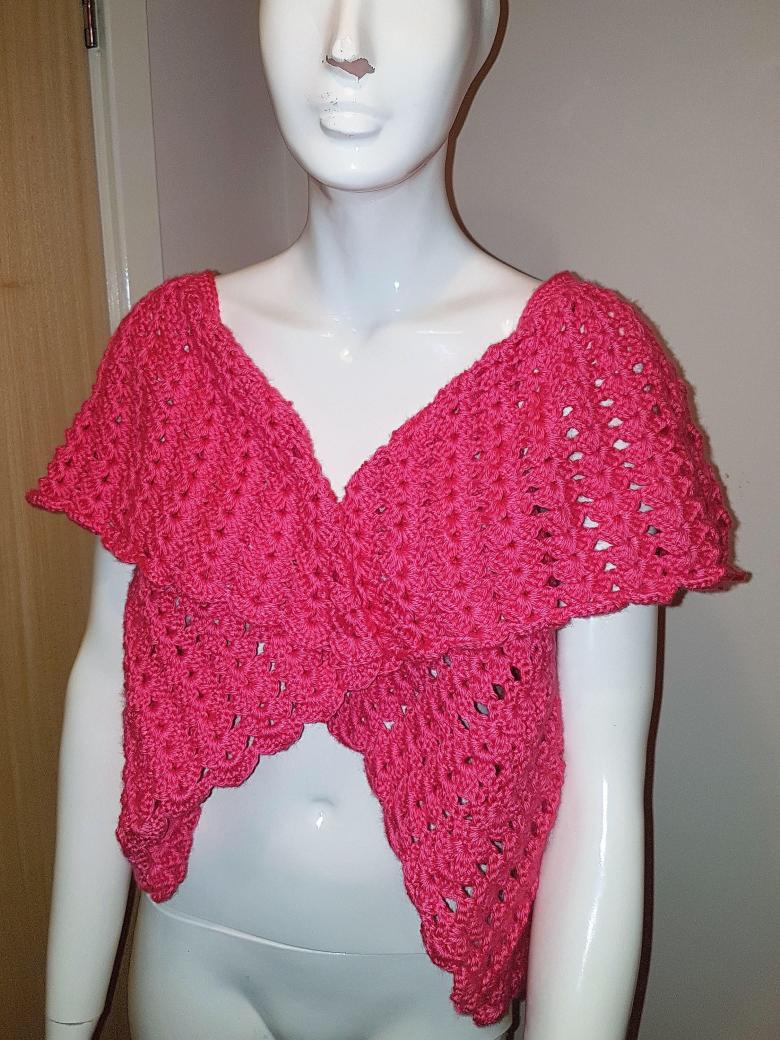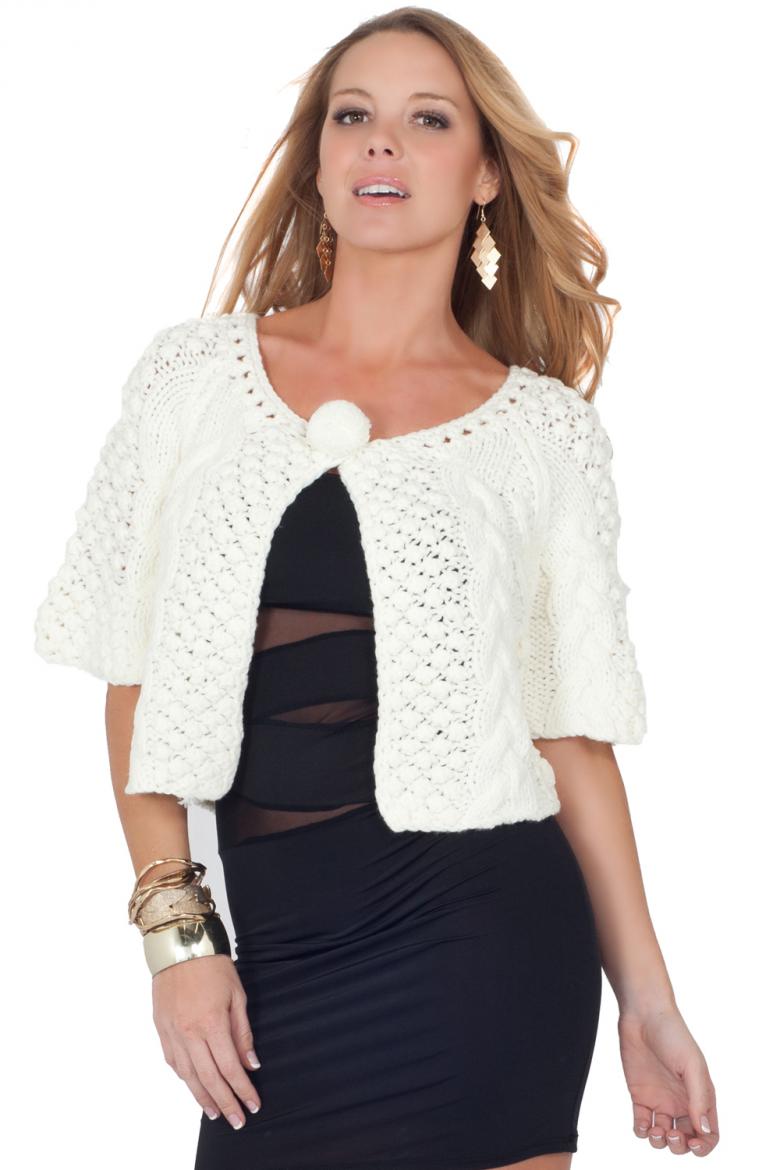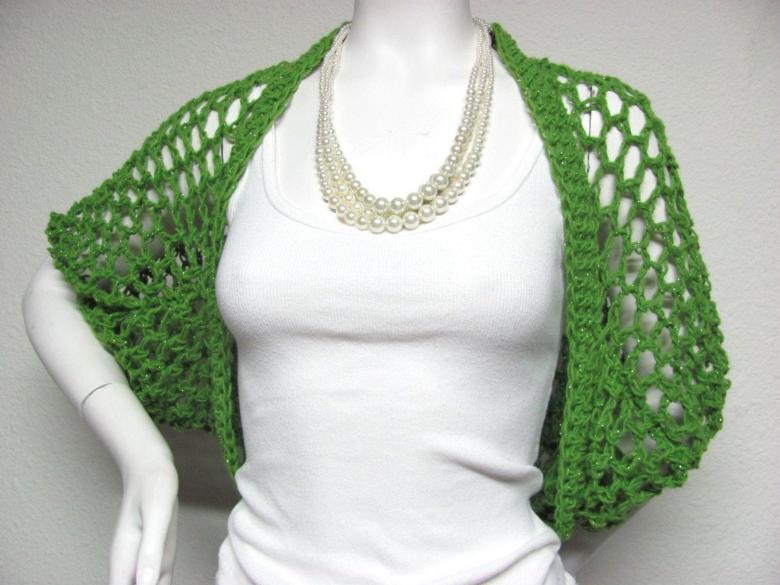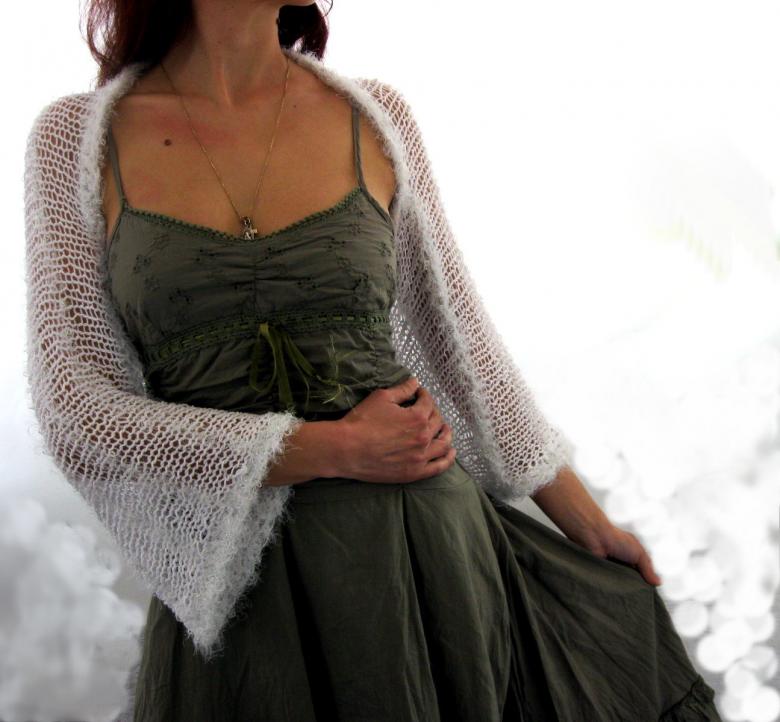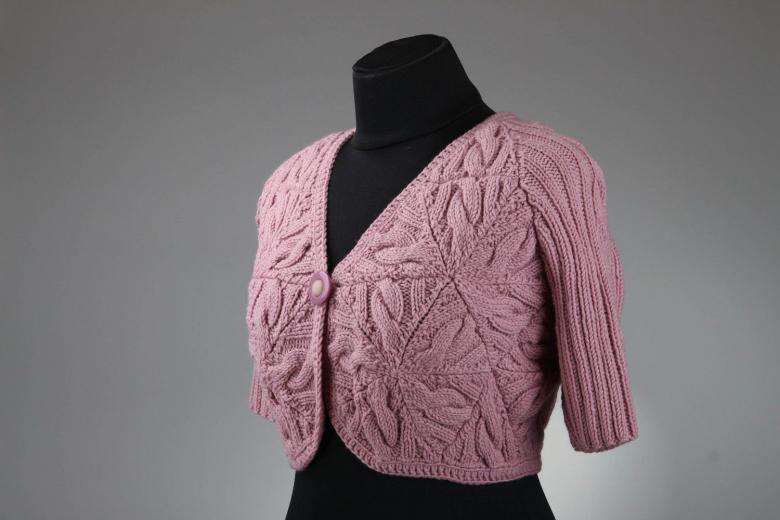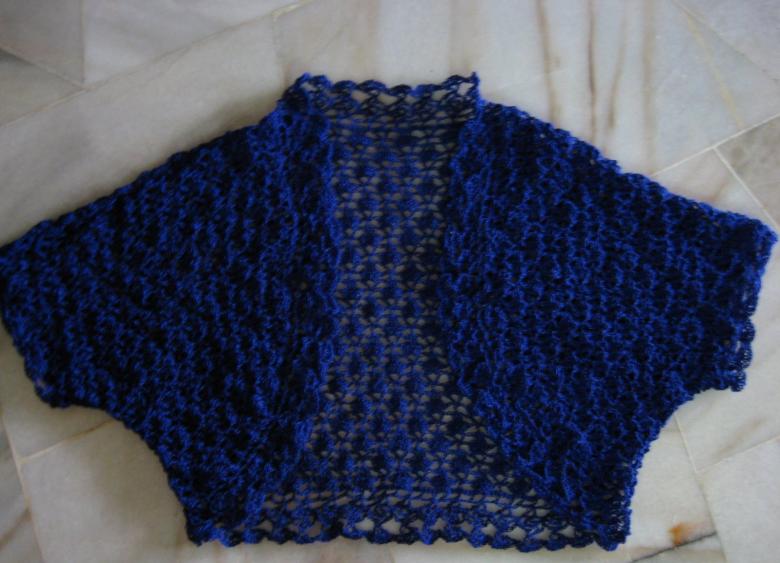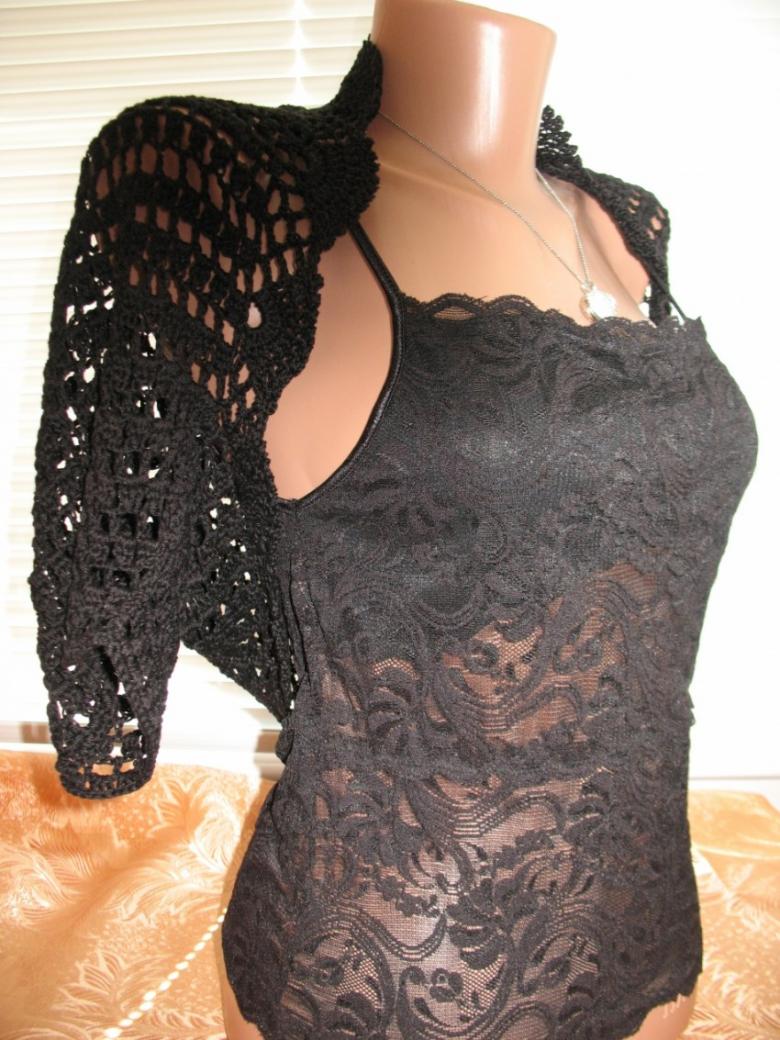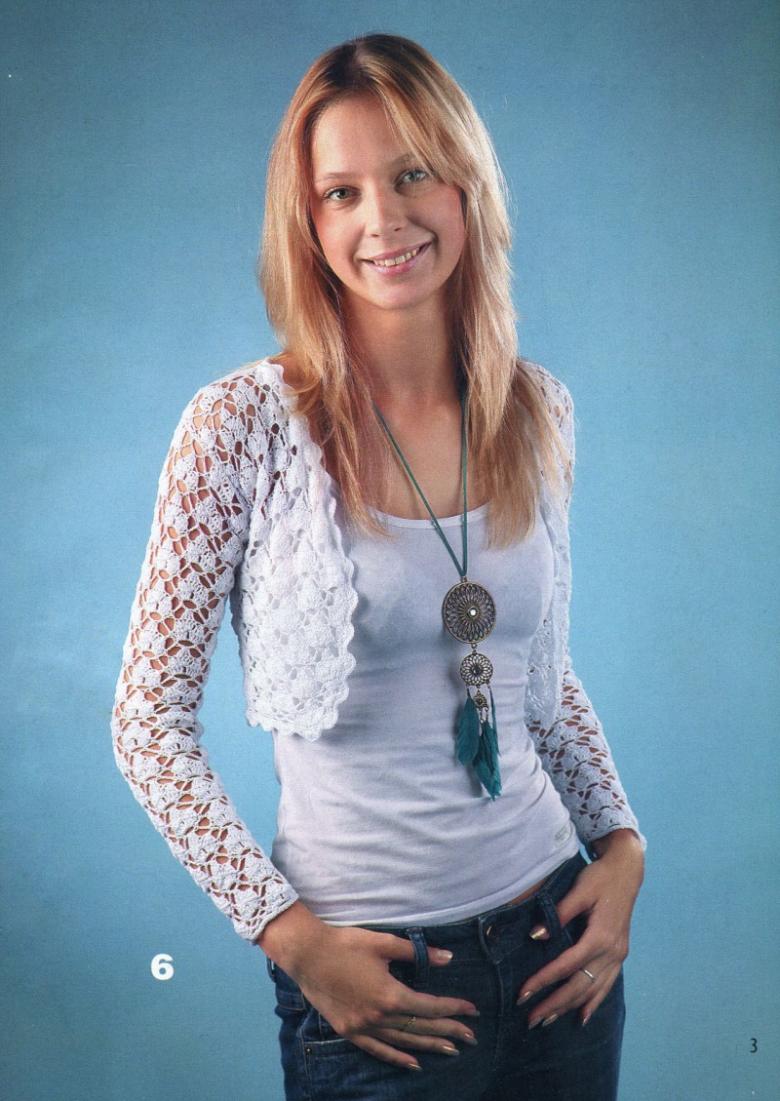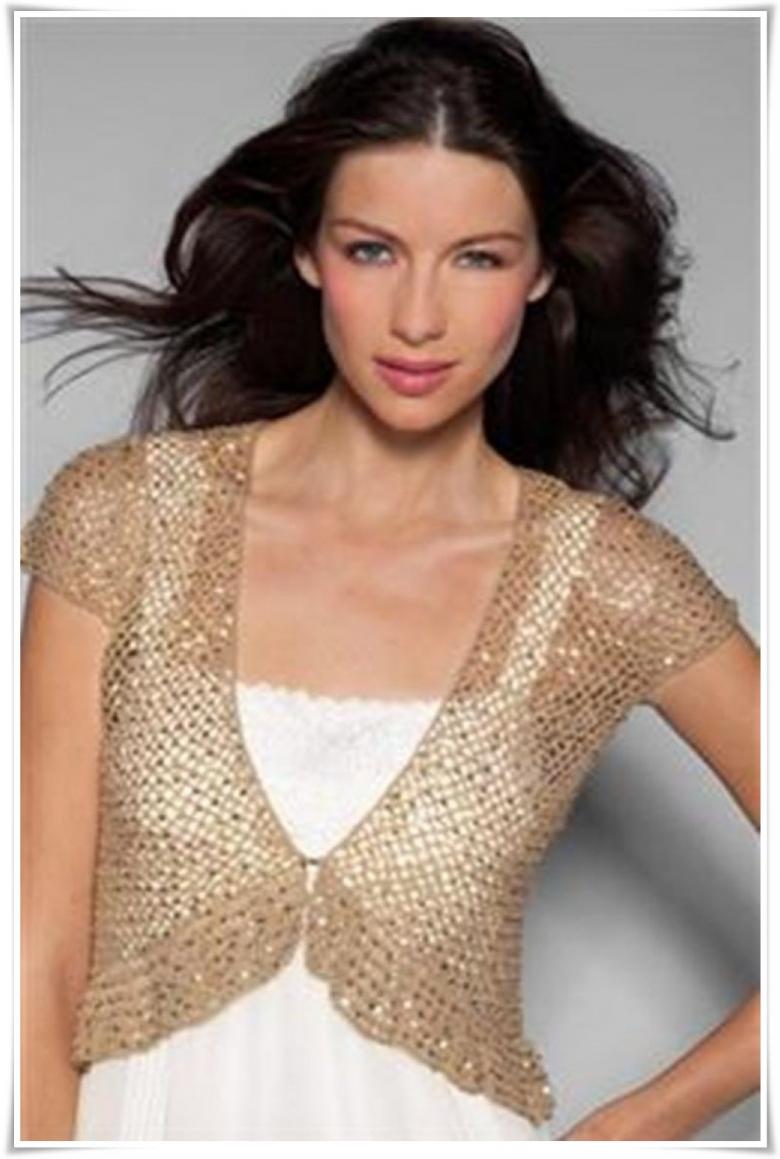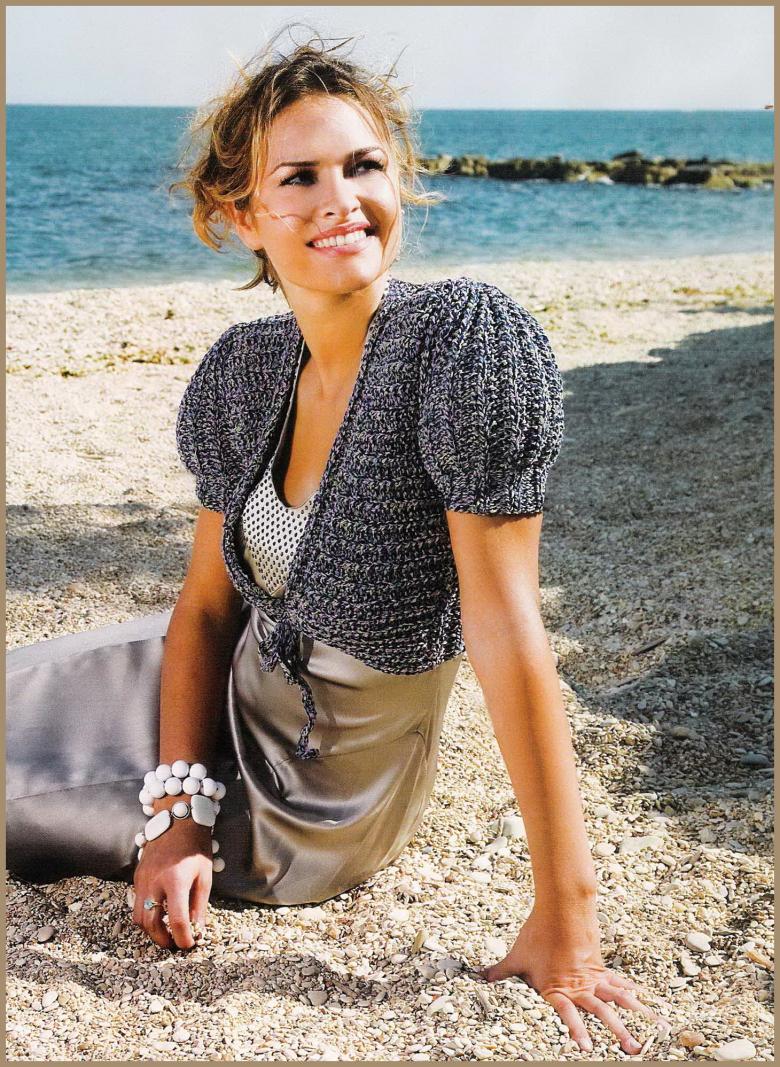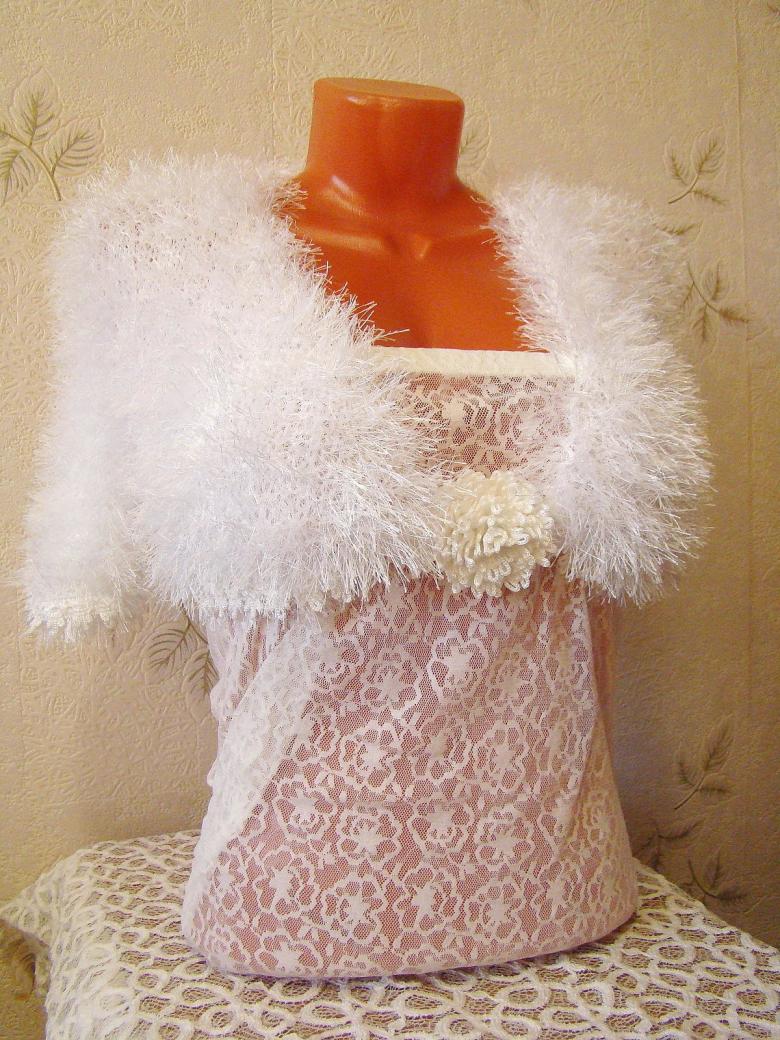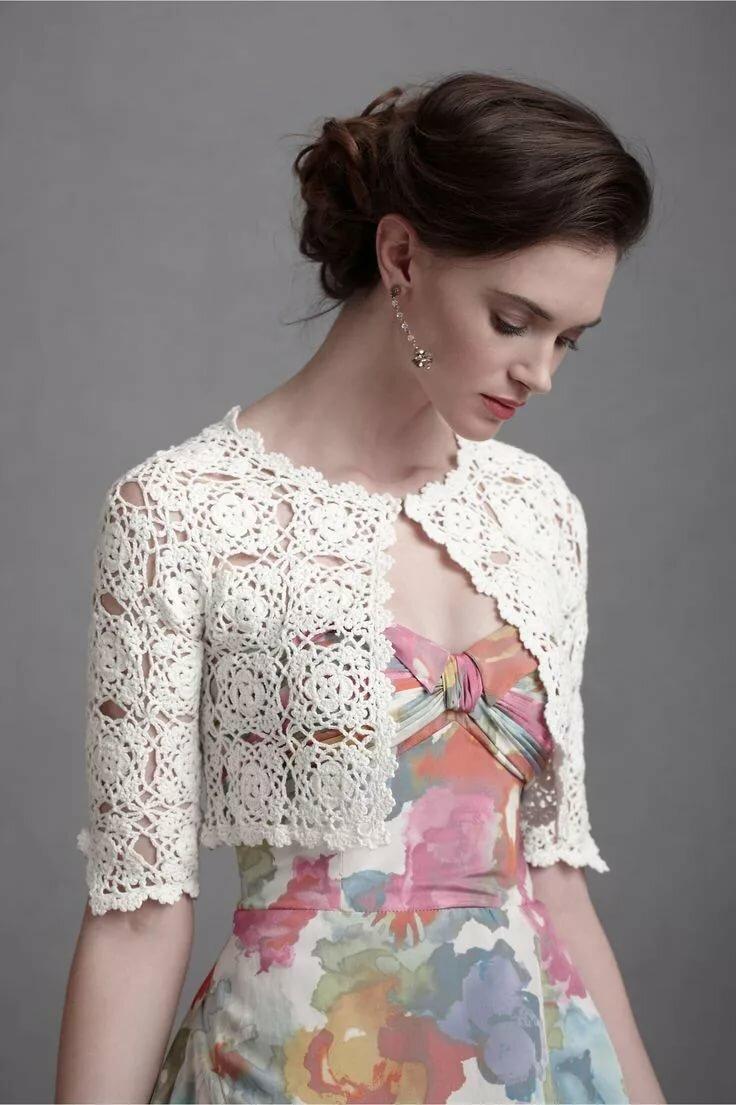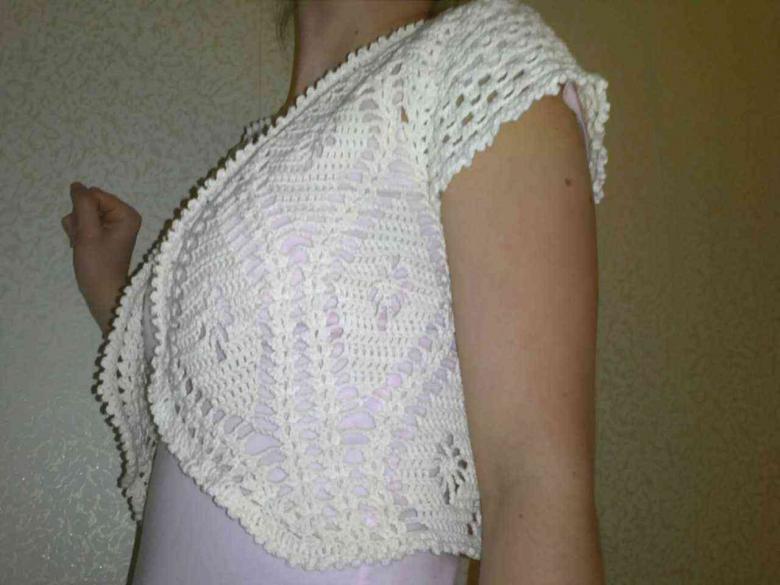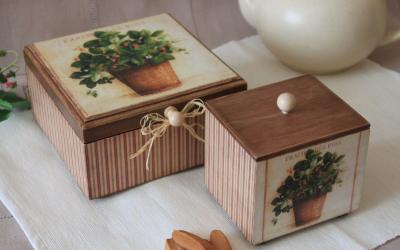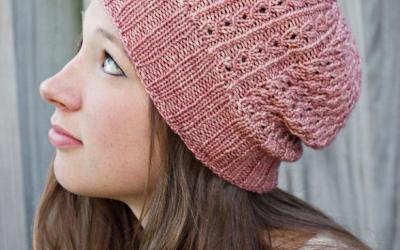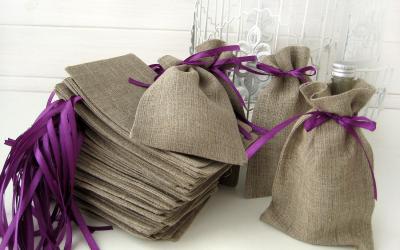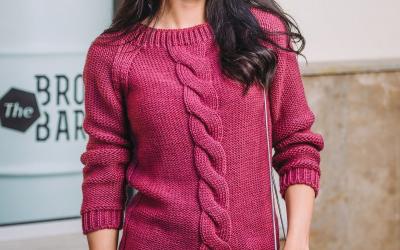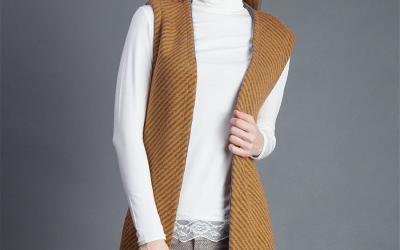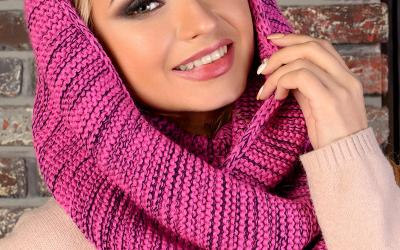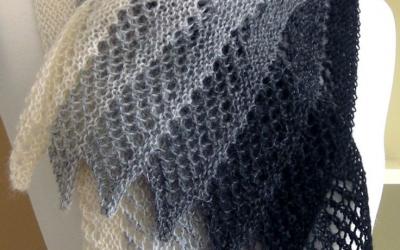How to knit a bolero by design and by crochet - Features, the choice of thread, a description of the scheme for beginners.
Knitting can rightly be attributed to the sphere of art. The skill of needlewomen is admired. At all times, a woman who knows how to knit, embodied the comfort, warmth of the home. The clothes created by her hands will always be original and unique. Any knitted product is an invaluable gift for yourself or a loved one.
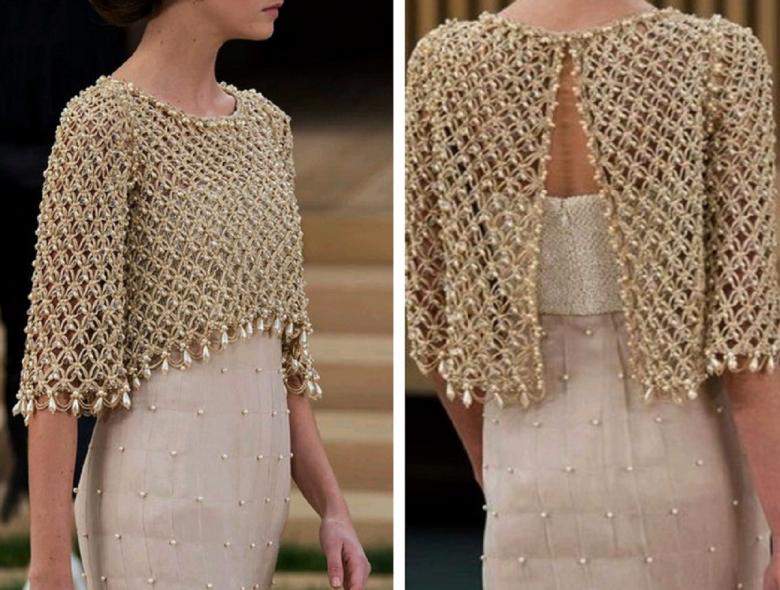
Knitted cozy cardigans, sweaters and blouses can be found in any woman's closet. But this type of clothing, such as jacket-bolero, do not yet have every fashionable woman. What makes this model different from others?
Description and purpose of the bolero
A bolero is a small shortened blouse or jacket, which slightly covers your shoulders and back. Along with the functional purpose it is also makes a decorative element - it decorates and emphasizes the created image in a single ensemble. A shortened length of this jacket emphasizes the waist and opens the beautiful curves of the body.

The history of bolero appearance is obliged to Spanish bullfighters. It was a tight-fitting short vest without a clasp, very richly embroidered and decorated with braid, embroidery and postsumami.
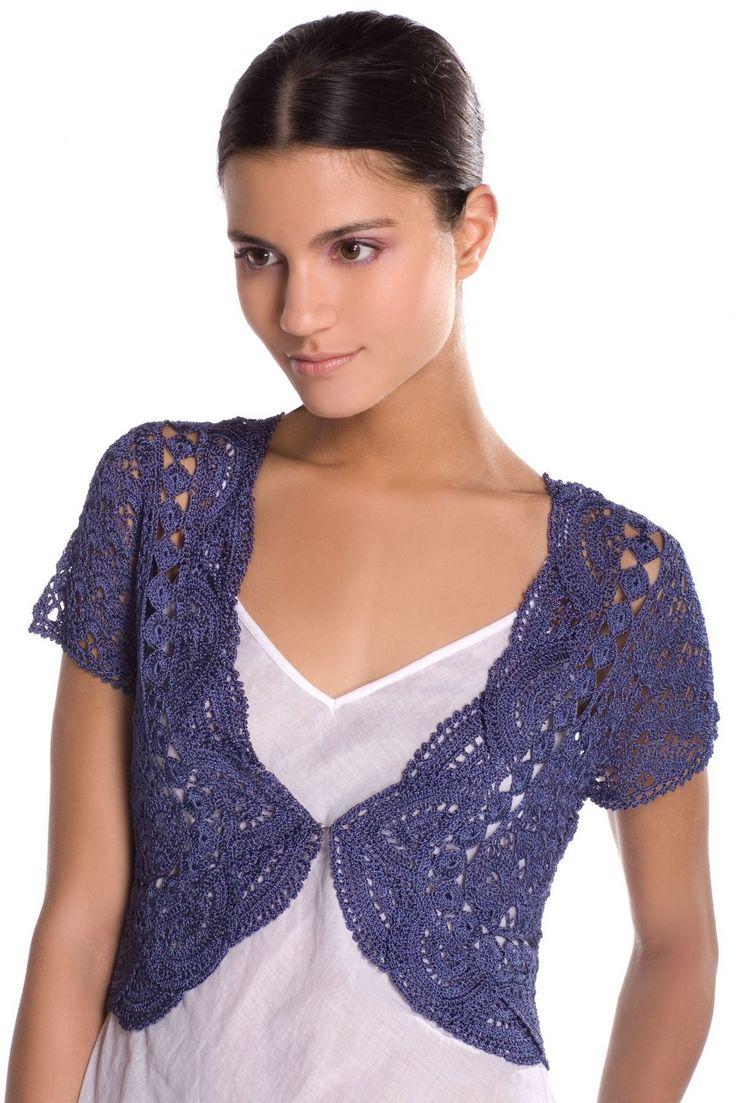
Women noticed how it advantageously emphasizes the figure and found it in a slightly modified form. And today a small bolero jacket has not lost its relevance.
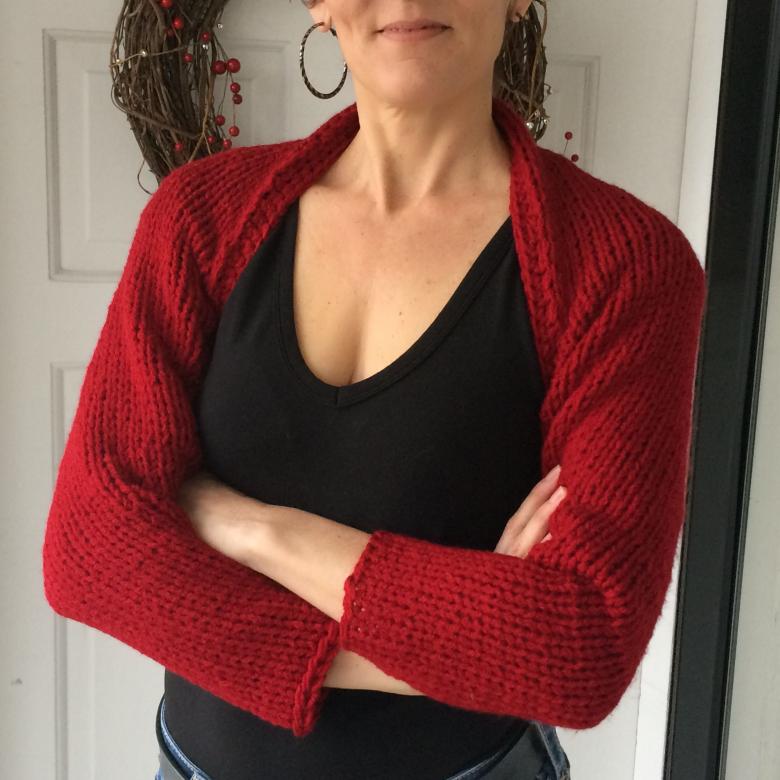
Going to the celebration, a woman always thinks: what if it gets cold, and in a dress or suit with open shoulders can get cold and feel uncomfortable. That is where the little jacket comes in handy. Properly selected model will be in harmony with the basic set of clothes, warm and even decorate woman as a stylish closet item.

Blazeroleur jacket may be very different in cut of sleeves, shape of neck, collar, clasp, but a distinctive feature of the bolero is its short length - no longer than 10 cm to the waistline. Bolero can be classic, sporty, romantic, very dressy and festive articles.
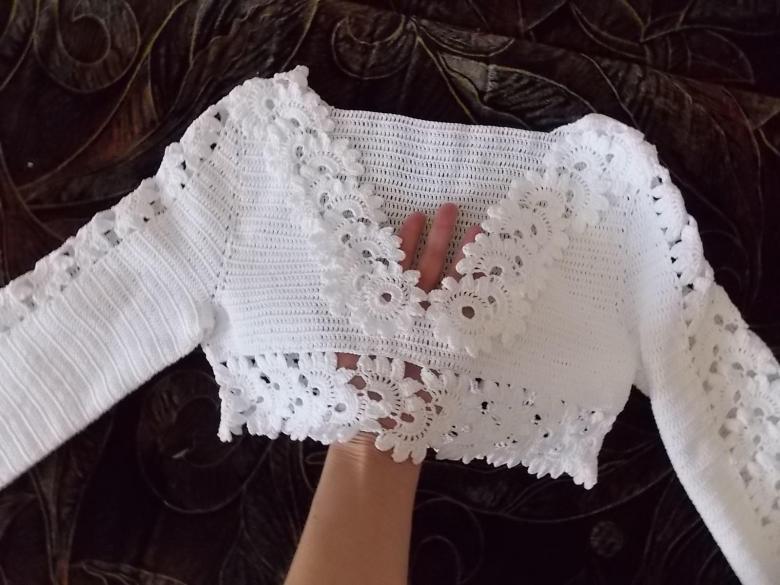
This piece of clothing to knit faster and easier than, for example, a sweater, jacket or blouse. Before you start knitting you should prepare and remember that by buying mediocre material you question the result of your work.
When choosing threads, don't forget: good quality means beautiful work.
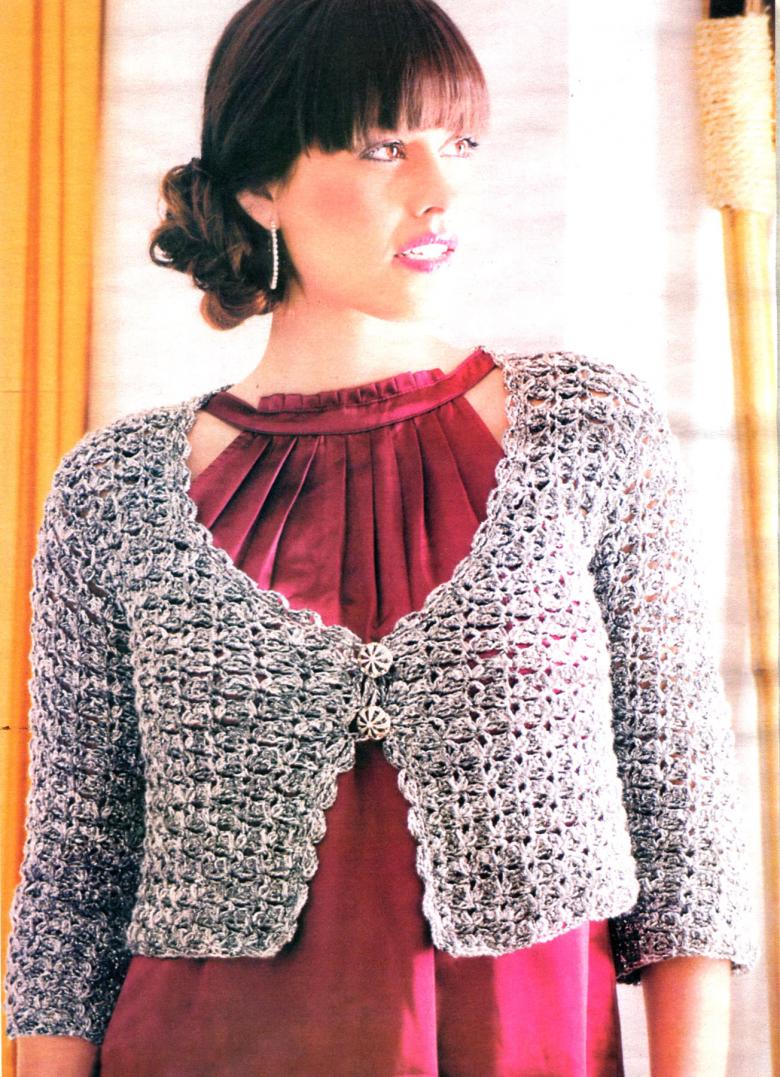
Choosing the threads
The threads used in knitting bolero can be different, depending on the purpose and your choice of model. For cold seasons, warm threads are more suitable, for warm seasons - thin and silky threads.
- Woolen threads are soft, create a feeling of comfort, keep warm. The disadvantages include the fact that they are somewhat "prickly" when touched, they can fall off and they need to be protected from moths.
- The advantages of choosing wool are still much more. And it is worth paying attention to its best kinds.
- Alpaca is a silky and durable wool. It is very warm, comes in beautiful bright and pastel colors.
- Cashmere is an unusually fine, silky, light and warm wool. It will be more expensive to buy, but it will also look decent.
- Mohair is a shiny, thin, elastic and fluffy version of wool. The color palette is usually very beautiful and varied in choice.
Wools such as camel, sheep and llama will be too heavy for a bolero. It is better to choose it for another product.

Silk, viscose, cotton and linen threads are better chosen for summer and dressy versions of clothes. You can mix them together. Work with these threads will be more laborious, time and money will have to spend more.
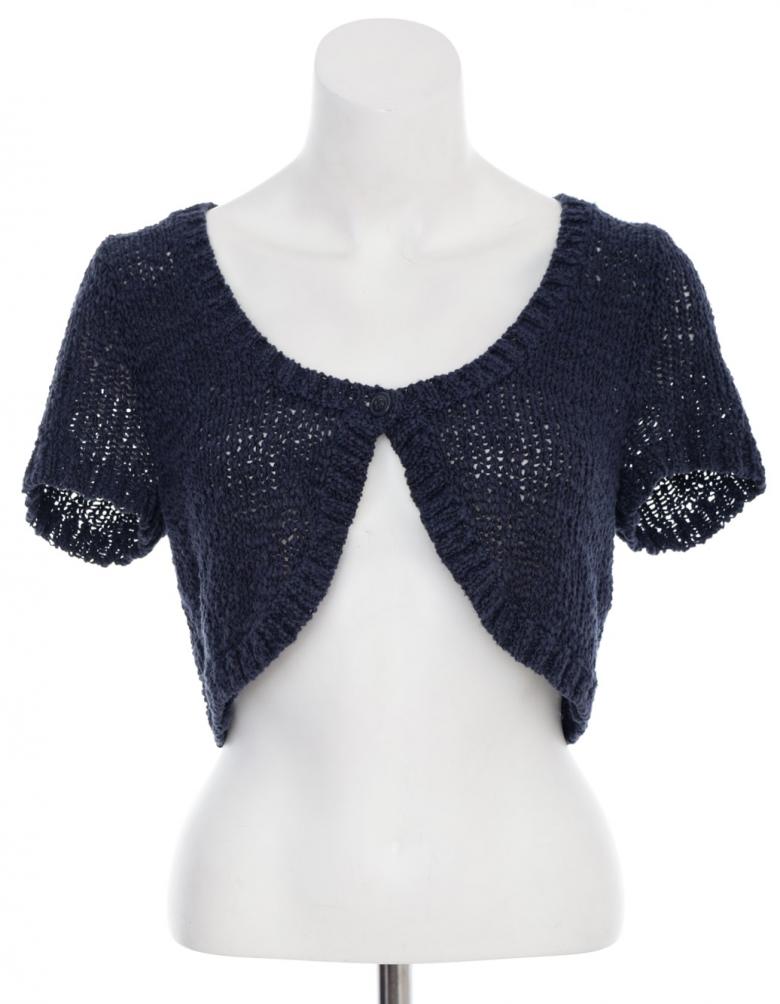
Artificial threads should not be excluded from consideration. Shiny, bright they can be complemented by natural threads. Products can be washed more often, without fear of deformation and rapid wear and tear.

Bolero without a pattern (for beginners)
It is not necessary to perform miracles of skill and high class, that would knit this model. The base for the finished product will be a big rectangle. It will turn out a simple and comfortable product.
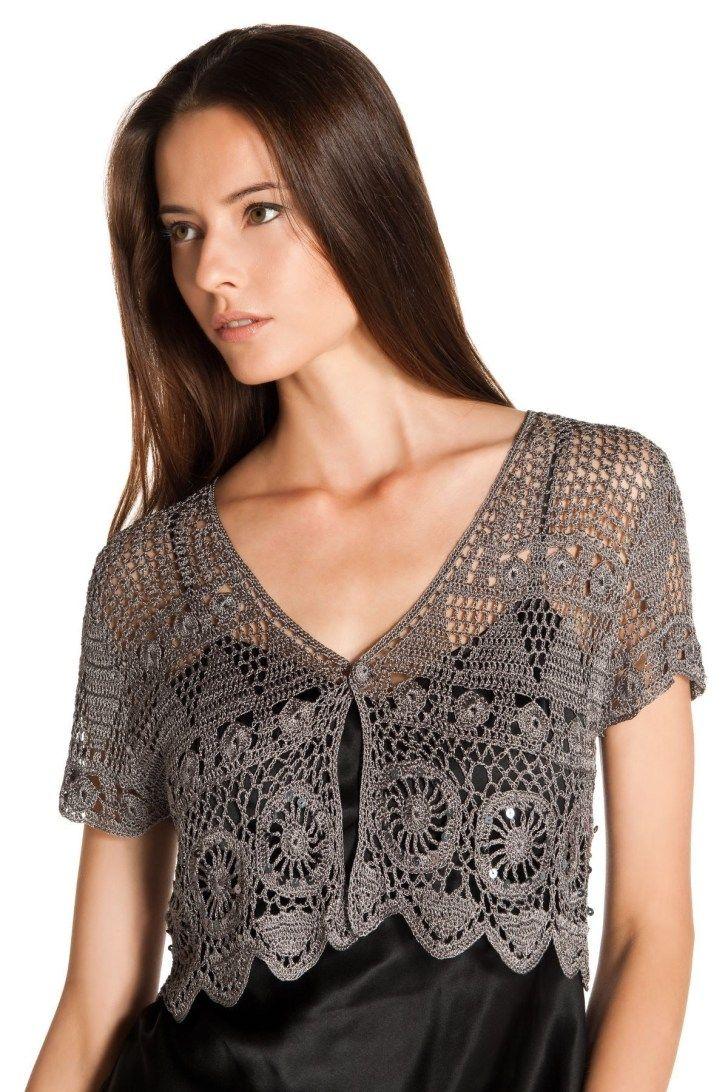
You will need:
- 200 g of yarn
- needles No 2-5
- 2 m of ribbon (for ties).
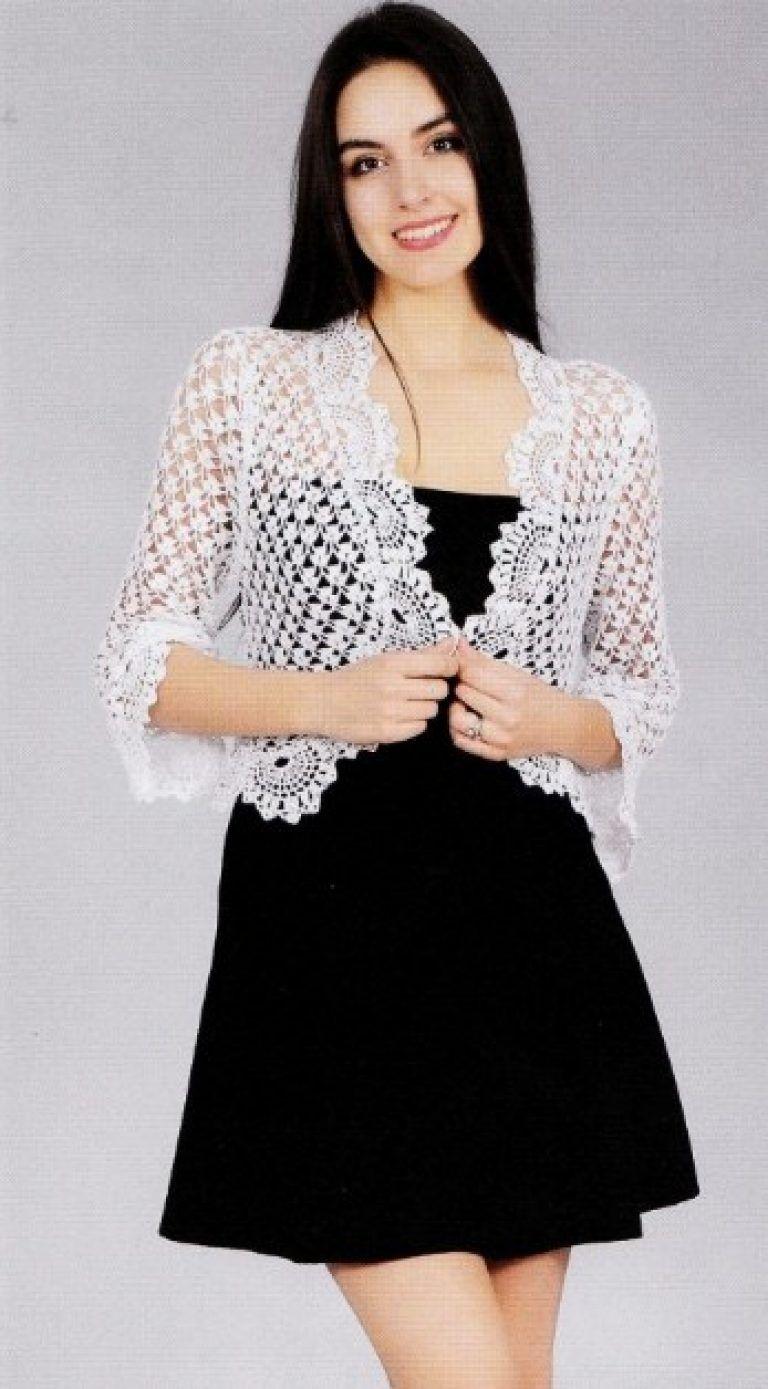
1×1 elastic band
- All rows: *1 front, 1 back*.
- Face glazing (stockinette knit):
- All even-numbered rows: all stitches are on the right side.
- All odd-numbered rows: all stitches are in the wrong side.
- Note: * denotes rapport (repeating pattern)
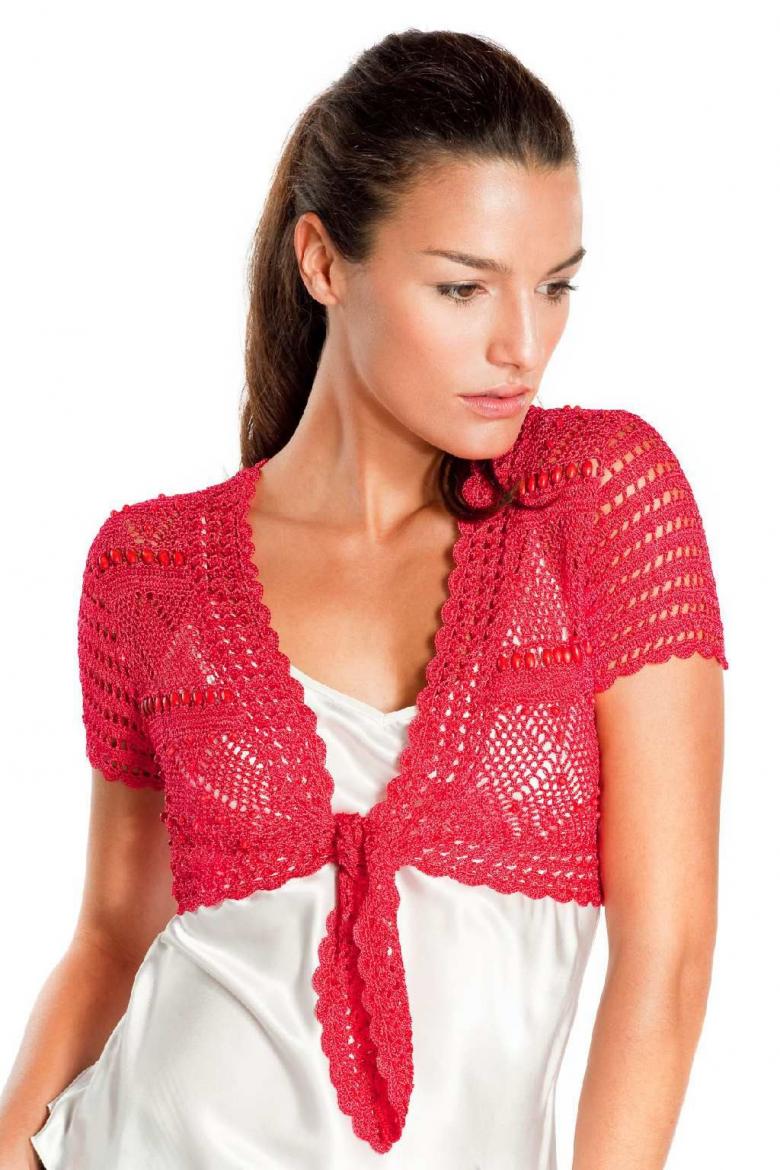
Job description:
- Recruit 302 loops, knit 10 cm on the height with 1x1 rubber band, then 35 cm on the face and the last 10 cm rows again with 1x1 rubber band. Close all stitches. The resulting armholes can be crocheted to prevent stretching.
- Assembly: fold the knit across the width on the wrong side. Sew each side of the rubber band along its height line. You will get 2 holes, which will form the sleeves. Put on the bolero. At neck level, fold the elastic band in half, to the chest line. Mark a place for the tie. Remove the bolero and attach a decorative ribbon (1m) on the wrong side of each side.
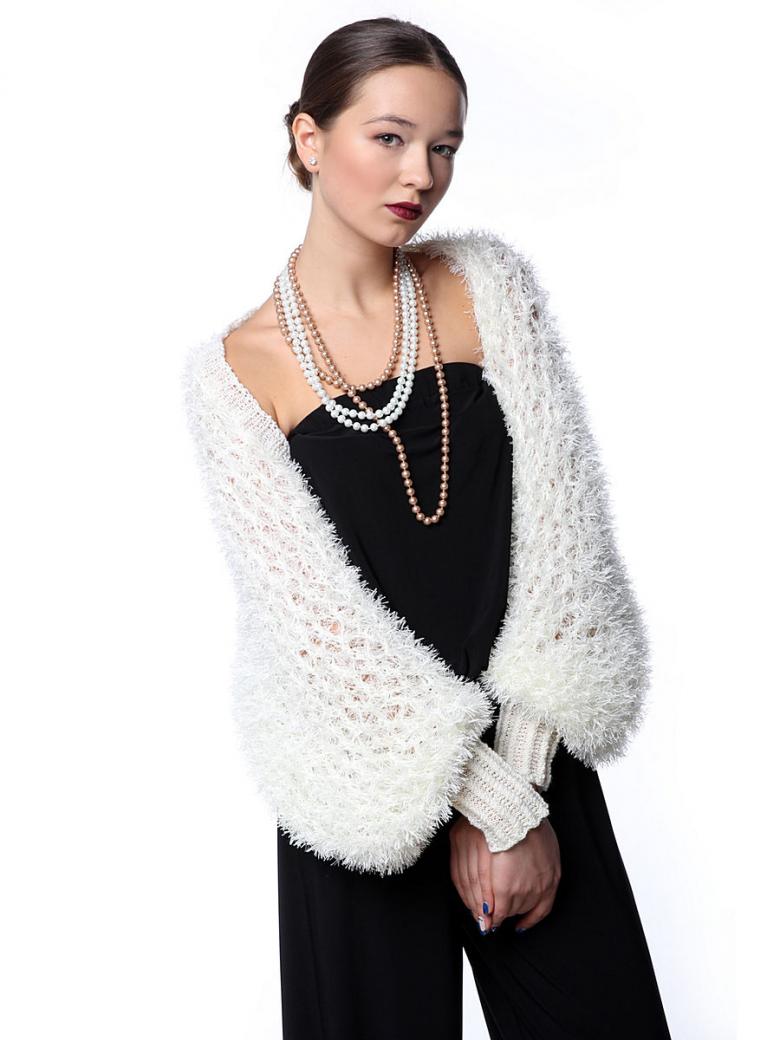
Bolero with colored stripes
This model consists of two mirror-symmetrical pieces, each of which forms a shelf, back, and sleeve (left and right sides) at the same time. When assembled, you get a side seam that transitions perpendicularly to the sleeve seam and a midline seam on the back.
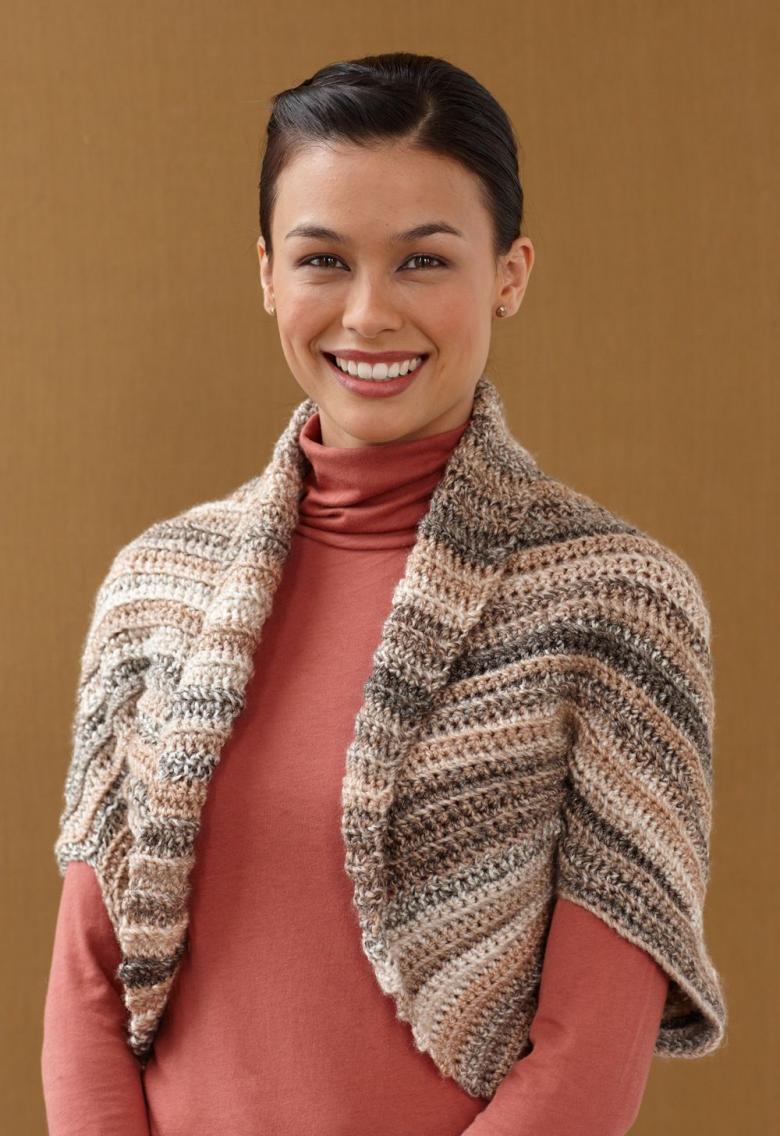
A separate pattern is not required. Given your measurements, draw a sketch where you determine the length of the bolero, the width at the bottom of the piece, and the length and width of the sleeve.
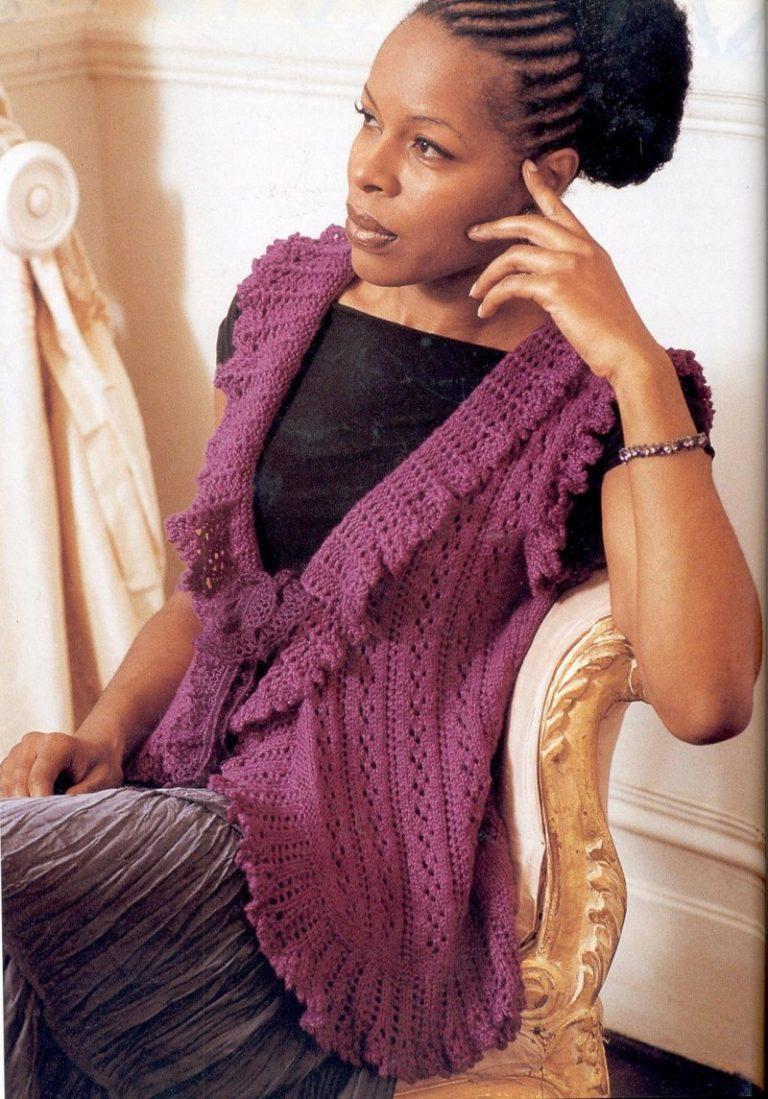
Will need:
- 300 g of yarn, 150 grams of different colors
- needles #5-6
- large decorative buttons.

Knitting pattern:
- Shawl knitting,
- Alternating colors in stripes 4-5 cm wide.
Shawl knitting:
- All stitches are knit on the front.
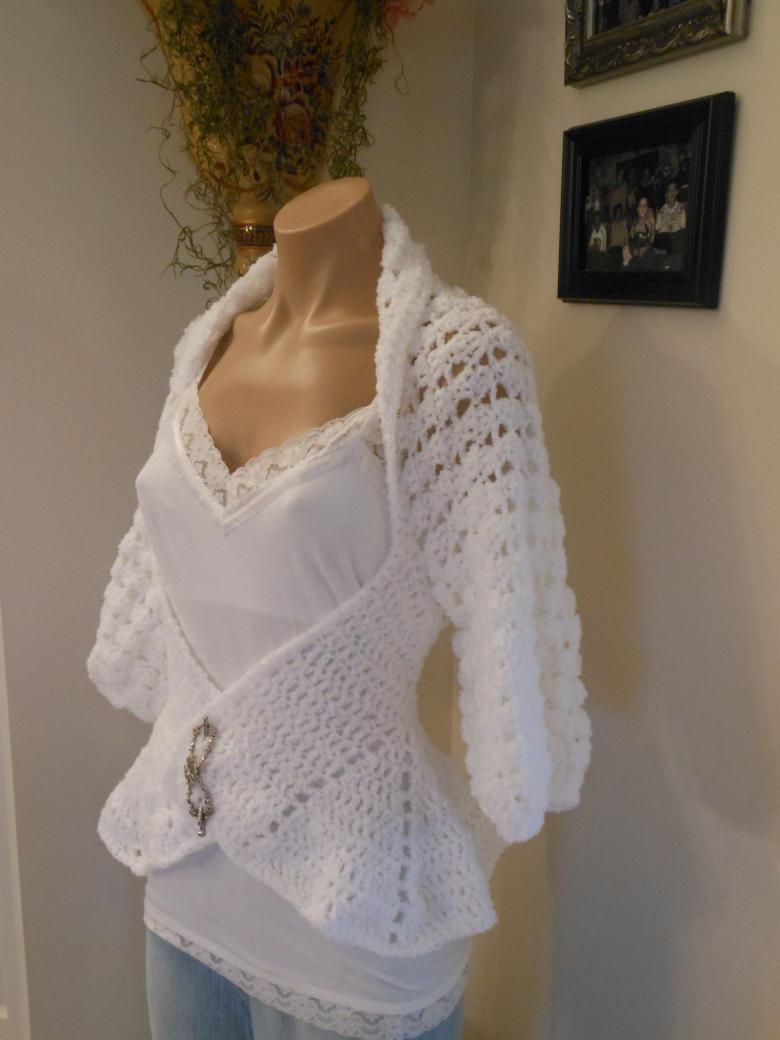
Please note: if you keep the back of the stitches to the right all the time, the knitting will be tighter and the work will not stretch and warp.

Job description:
- The knitting will be transverse. Knit one piece first, then the other. Start at the bottom of the sleeve. Taking into account the calculation of the loops on the needles dial in the number of loops for the desired width of the sleeve. Knit the sleeve to a length of 20-25 cm (or according to the sketch), alternating bands of color.
- For the transition to the shelf and back typed a simple set (as in the beginning of knitting) on each side of the knitted sleeve loops to set the length of the product on the side seam - 12 - 18 cm (or sketch) and continue knitting. Do not forget to alternate strips of different colors. The wider the sleeve, the shorter the side seam. Knit in the middle of the strips and back vertically.
- Close the loops.
- Fold parts in half. With a knitting needle or crochet, sew the side and sleeve seams. Sew the middle seam along the back to the height of the back neck.
- Make a fitting. It remains to mark the place for the button at chest level and sew her details on each side.
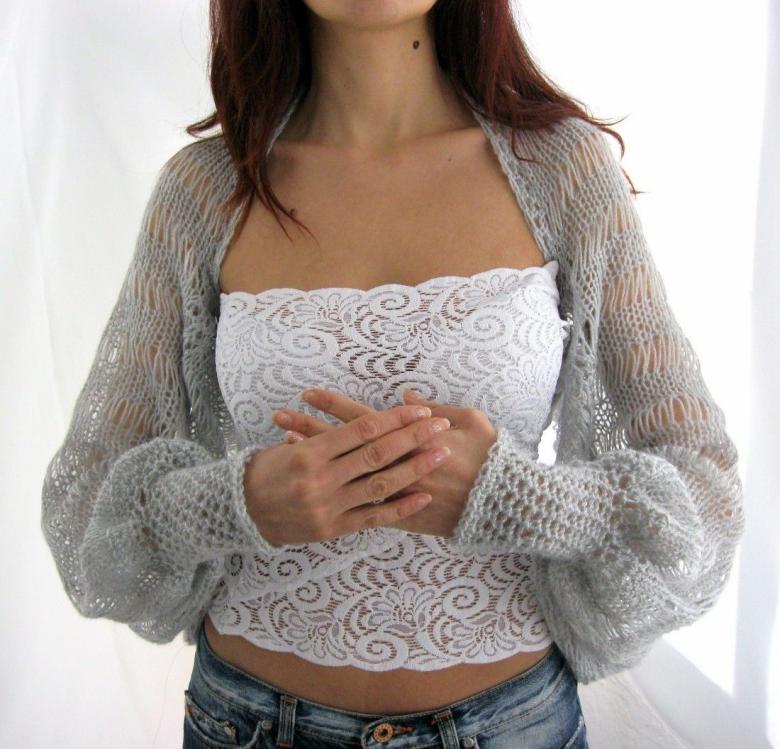
Elegant bolero, openwork knitting
Bolero, knitted with tracery, will be elegant. The design of the pattern is also based on a rectangle, and the strapping will be made in a circle with a rubber band
We will need (for size 46) :
- 100 grams of light yarn
- Needles #4-5 (short and long).

Knitting pattern:
Choose a "lancet" openwork pattern:
- Dial in a number of loops divisible by 8, add 1 more loop.
- 1st row and all odd-numbered rows: all stitches are in the wrong.
- 2nd row: 1 right side, *fold, 2 right side, 3 stitches together, 2 right side, fold, 1 right side*.
- The 4th row: 1 front, *1 front, ″Need, 1 front, 3 stitches together, 1 front, ″Need, 2 front*.
- 6th row: 1 front, *2 front, ″button, 3 stitches together in a lop, ″button, 3 front.
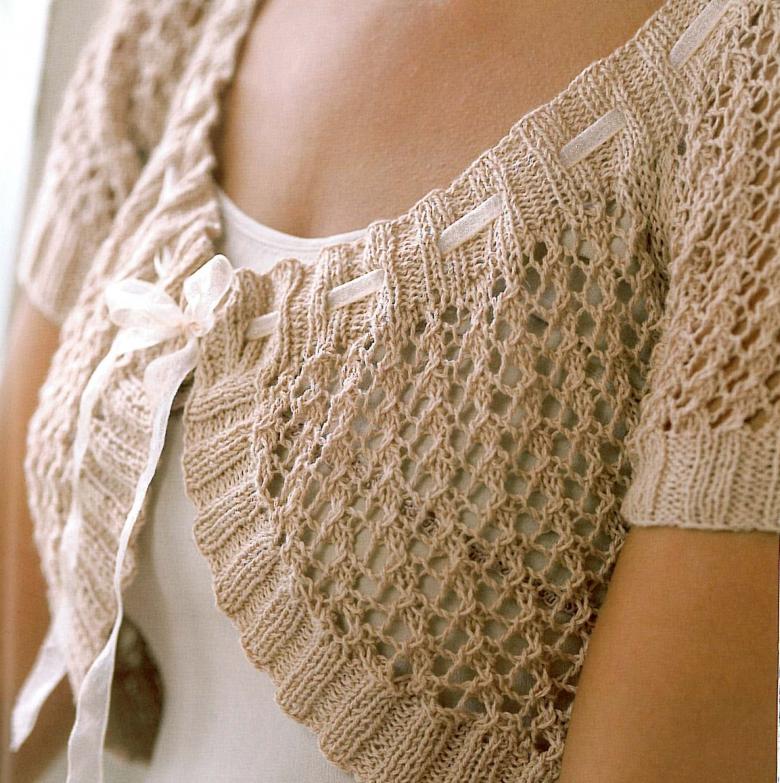
For the banding choose a rubber band 2x2.
- All rows: *2 front, 2 back*.
Description:
- On the needles dial 89 loops, knit straight openwork according to the description height of 88 cm.
- The product is folded in half lengthwise and perform 10 cm sleeve seams on both sides.
- On long needles we gather the loops on the contour into a ring and knit a rubber band in a circle of about 8-10 cm, remembering to put a mark with a contrasting thread at the beginning of the circular knitting.
- Close the loops.
- Try on the product. If necessary, you can sew on the level of the chest or just above the button to fasten, use a decorative pin.

A classic bolero (combining jersey and knitted fabric).
You can use a ready made jersey knitted fabric and complement it with a spliced trim. The chosen black color will give the product both a business character and dressiness for festive occasions.
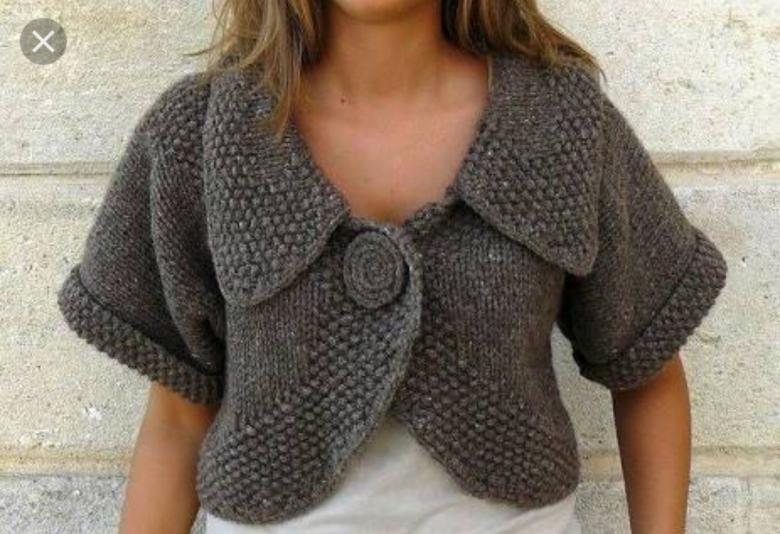
Use the ready made pattern to cut the jersey. You will need only 50cm of fabric with a width of 110cm. Sew the pieces by hand or machine with the edge trimmed.
For the knitted trim you will need:
- Yarn - 200 g (for example: merino wool 225m/50 g)
- Needles No 2,5 (+ one needle No 2,5 auxiliary).

Rubber band 2x2:
- All rows: *two fingers, two toes, two toes*.
1×1 stitch:
- All rows: *1 front, 1 back, 1 back*.
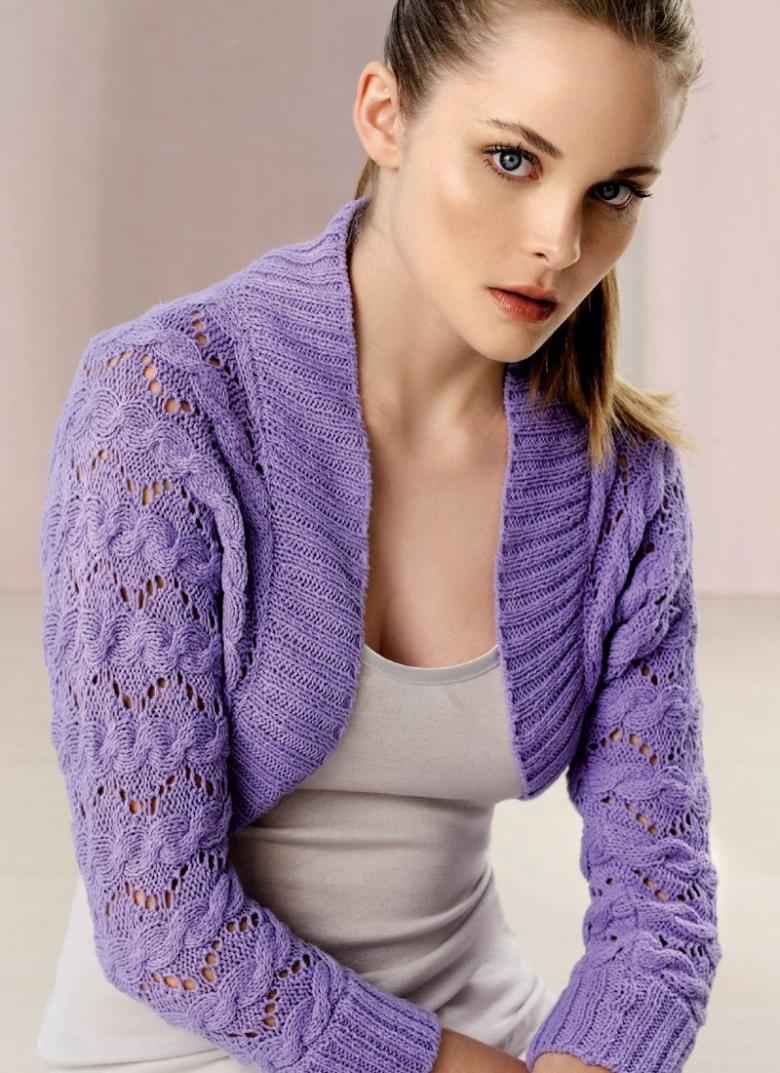
Description:
- For the shelf and back strips, dial in 438 loops and knit 4 rows of hollowed-out rubber and 68 rows of 2x2 rubber, for a total height of -16.5 cm. Next, knit 8 rows with a hollowed stitch.
- Divide the halter stitch into two parts by removing the stitches of the layer on the front side on an auxiliary needle, and close the stitches of the layer on the wrong side.
- For the sleeve placket, type 68 loops in 1x1 stitches, knit at a height of only 1.5 cm. Leave the loops open at the end of the knitting.
- Take the stitched part of the bolero and sew the open loops of the large placket with a backstitch, starting at the side seam. Sew the loops of the second layer on the wrong side, taking the jersey layer inside. Close up the side of the placket.
- Sew the open loops of the sleeve slats one at a time with a back-and-forth stitch in the same way.
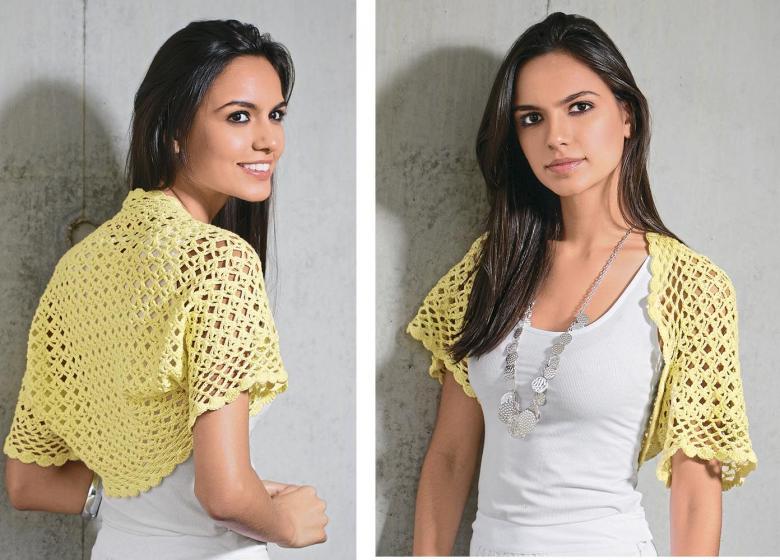
The bolero can be knitted for festive occasions such as weddings. Using "grass" yarn, you can get the effect of a uniform, silky furry fabric, which will keep the bride warm and adorn her shoulders.
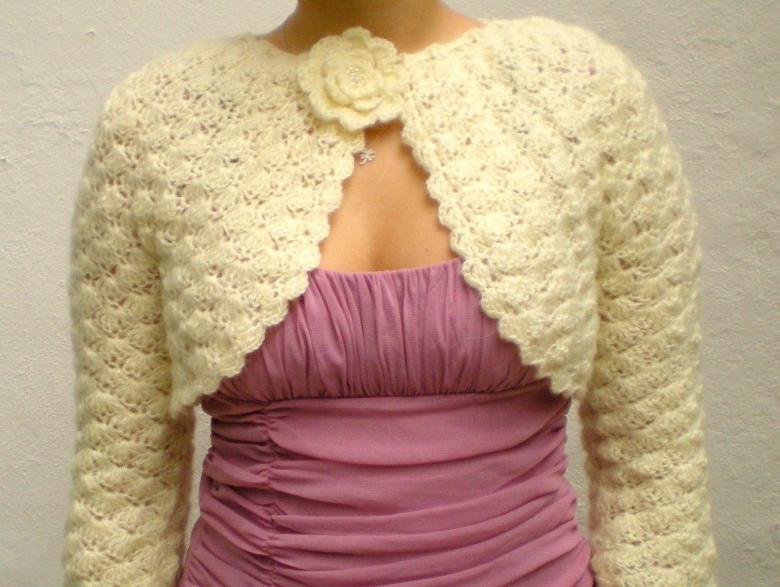
It is very neat and easy to knit a bolero jacket on circular needles with a raglan sleeve effect, starting from the neckline. Usually such models are suitable for girls. It looks beautiful, provides warmth for the child, does not prevent him from running and playing.

Based on a ready-made pattern or using your own sketch, experimenting with color and pattern, you can make a wonderful model of bolero, which will keep you warm and decorate.

